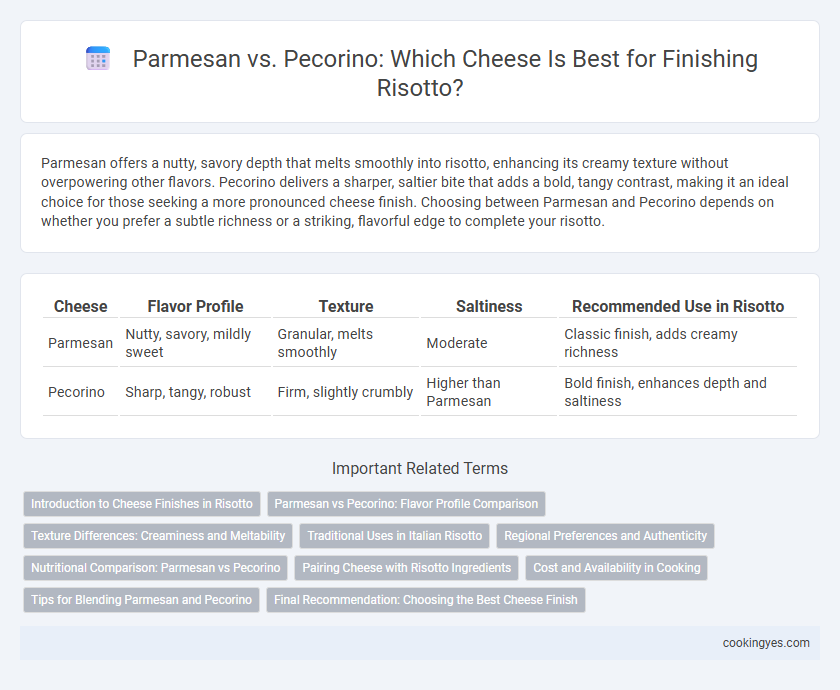Parmesan offers a nutty, savory depth that melts smoothly into risotto, enhancing its creamy texture without overpowering other flavors. Pecorino delivers a sharper, saltier bite that adds a bold, tangy contrast, making it an ideal choice for those seeking a more pronounced cheese finish. Choosing between Parmesan and Pecorino depends on whether you prefer a subtle richness or a striking, flavorful edge to complete your risotto.
Table of Comparison
| Cheese | Flavor Profile | Texture | Saltiness | Recommended Use in Risotto |
|---|---|---|---|---|
| Parmesan | Nutty, savory, mildly sweet | Granular, melts smoothly | Moderate | Classic finish, adds creamy richness |
| Pecorino | Sharp, tangy, robust | Firm, slightly crumbly | Higher than Parmesan | Bold finish, enhances depth and saltiness |
Introduction to Cheese Finishes in Risotto
Parmesan and Pecorino are both popular cheese finishes that enhance risotto's creamy texture and rich flavor profile. Parmesan provides a nutty, mellow taste with a smooth melt, perfect for classic risotto dishes, while Pecorino offers a sharper, saltier bite, adding depth and complexity. Selecting between Parmesan and Pecorino influences the dish's overall seasoning and balances risotto's inherent creaminess, making cheese choice essential to flavor customization.
Parmesan vs Pecorino: Flavor Profile Comparison
Parmesan cheese brings a nutty, savory flavor with a granular texture that melts smoothly into risotto, enhancing its creamy richness. Pecorino offers a sharper, saltier taste with a tangy bite, derived from sheep's milk, adding a bold contrast to the dish. Choosing between Parmesan and Pecorino depends on whether a milder, buttery finish or a more intense, piquant flavor is desired for the risotto.
Texture Differences: Creaminess and Meltability
Parmesan cheese offers a smooth, creamy texture that melts uniformly, enhancing the risotto's silkiness and creating a cohesive mouthfeel. Pecorino, with its firmer and slightly grainy texture, melts less evenly, providing a bolder, more rustic finish with noticeable cheese granules. The choice between Parmesan and Pecorino affects the risotto's overall creaminess and meltability, influencing both texture and flavor integration.
Traditional Uses in Italian Risotto
Parmesan, or Parmigiano-Reggiano, is traditionally favored in Northern Italian risotto for its nutty, umami-rich profile that enhances the creamy texture without overpowering the dish. Pecorino Romano, with its sharper and saltier taste, is more commonly used in Central and Southern Italian recipes but is rarely applied to classic risottos. Authentic risotto recipes adhere to regional cheese preferences, ensuring that Parmesan remains the quintessential finishing cheese for a traditional Northern Italian risotto.
Regional Preferences and Authenticity
Parmesan, known for its nutty and delicate flavor, is traditionally favored in Northern Italian regions like Lombardy and Veneto for finishing risotto, ensuring authentic taste and texture. In contrast, Pecorino, with its sharper and saltier profile, is commonly used in central Italy, particularly Tuscany and Lazio, reflecting regional preferences that emphasize boldness and intensity. Choosing between Parmesan and Pecorino not only influences the flavor complexity but also preserves the cultural authenticity of the risotto based on its geographic origin.
Nutritional Comparison: Parmesan vs Pecorino
Parmesan cheese contains approximately 431 calories and 35 grams of protein per 100 grams, offering a rich source of calcium and phosphorus critical for bone health. Pecorino provides about 387 calories and 28 grams of protein per 100 grams, with higher sodium content and a stronger presence of vitamin A compared to Parmesan. When finishing risotto, Parmesan adds a lower sodium and higher protein option, whereas Pecorino contributes more intense flavor with increased sodium and vitamin A.
Pairing Cheese with Risotto Ingredients
Parmesan offers a nutty, creamy flavor that enhances risotto dishes featuring mushrooms, asparagus, or chicken, while Pecorino provides a sharper, saltier taste ideal for risottos with sausage, kale, or rich tomato sauces. Parmesan's subtle umami complements delicate, earthy ingredients without overpowering them, whereas Pecorino's bold profile balances heartier, robust flavors. Choosing between the two cheeses depends on the risotto's primary ingredients and the desired intensity of the final dish.
Cost and Availability in Cooking
Parmesan is widely available and generally more affordable than Pecorino, making it a popular choice for finishing risotto in many kitchens. Pecorino, often pricier and less common, brings a sharper, saltier flavor but may be harder to source depending on the region. Choosing Parmesan improves cost-effectiveness and accessibility without compromising the creamy texture essential to risotto.
Tips for Blending Parmesan and Pecorino
Blending Parmesan and Pecorino in risotto creates a balanced flavor profile by combining Parmesan's nutty sweetness with Pecorino's sharp, salty bite. Use grated Parmesan for its creamy texture and Pecorino in smaller amounts to add depth without overpowering the dish. Stir the cheeses in at the end of cooking off the heat to maintain a smooth, velvety finish and prevent curdling.
Final Recommendation: Choosing the Best Cheese Finish
Parmesan offers a nutty, savory flavor with a granular texture that melts smoothly into risotto, enhancing creaminess without overpowering other ingredients. Pecorino provides a sharper, saltier taste derived from sheep's milk, delivering a bold contrast ideal for richer or spicier risotto variations. For a balanced finish, Parmesan is recommended for its versatility and subtlety, while Pecorino suits dishes that benefit from a pronounced, tangy cheese profile.
Parmesan vs Pecorino for cheese finish Infographic

 cookingyes.com
cookingyes.com